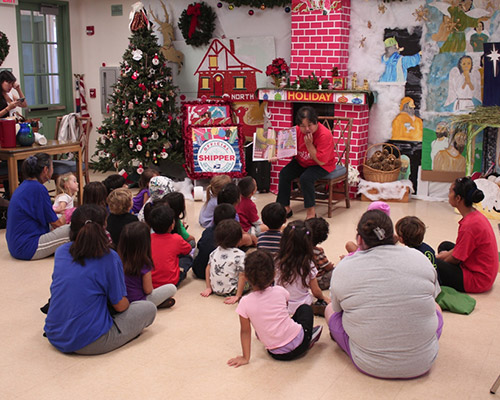Why Read Aloud

- Reading aloud nurtures a child's sense of security and worth.
- Reading aloud creates a bond between the reader and the child.
- Reading aloud to young children helps to develop vocabulary, oral language skills, fluency, and a positive attitude toward learning.
- By age three, children who are read aloud to and conversed with daily will have heard at least 30 million more words than children who are not read to. (Drs. Betty Hart and Todd Risley, Meaningful Differences in the Everyday Experience of Young American Children)
- Reading aloud to children exposes them to three times more unusual (rare) words than everyday conversation.
In addition to read-aloud information, recent brain-development research reveals the following:
- The first three years of life are critical years for brain development and for emotional and intellectual growth.
- Most of a child's brain development takes place after birth, when the child's 100 billion brain cells eventually connect in networks that allow thinking and learning to take place.
- The brain is wired for learning through connections which are created by positive stimulation, such as singing, touching and reading aloud. Such connections help the child to form attachments to parents, family members, and other caregivers.
- A child's sense of security and worth, so essential in raising healthy children capable of handling stress later in life, is nurtured through positive experiences such as reading aloud.
Read Aloud Tips
(download Read Aloud Tip Sheet)
- Take ten minutes every day to read aloud to your child.
- Schedule a time each day and find a reading place; create a routine.
- Let your child choose the book.
- Show the cover, introduce the author and illustrator.
- Ensure your audience sits close to you and close to each other.
- Enjoy yourself! Throw yourself into it so you’re never boring!
- Welcome everyone with roving eye-contact on the first few lines.
- Be expressive and have fun, feel the emotions.
- Don’t rush, speak slowly and loud enough for everyone to hear.
- Engage the listener through “repeat after me,” gestures and other Physical movement.
- Ask questions as you read, “what do you think will happen next?”
- Make the phrases into beautiful, lilting, up & down music.
- Change vocally: high/low; loud/soft; fast/slow.
- Speak the verbs with animation, even though they look boring.
- Fall in love with the pause.
- Say goodbye to everyone with roving eye-contact on the last lines.
- Speak the last line v-e-r-y slowly.
- Don’t speak right after you have finished: allow a few seconds of total silence for “the feather to fall to the floor”
- Visit the library together.
- Read all kinds of things with your child: recipes, instructions, sports news, magazines, even the tv schedule.
- Let your child see you read.
- Select a book that you like and practice reading it.
- After: Discuss the 5 w’s: who, What, When, Why and Where.
- Discuss sequence: Beginning, Middle and End of the story
Read Aloud Techniques
- Move your finger under the words as you read.
- Let your child turn the pages.
- Act out the characters with your voice as you read.
- Take turns reading words, sentences, or whole pages.
- Pause and ask open-ended questions like: "How would you feel if you were that person?" "What do you think will happen next?"
- Discuss what is happening in the pictures.
